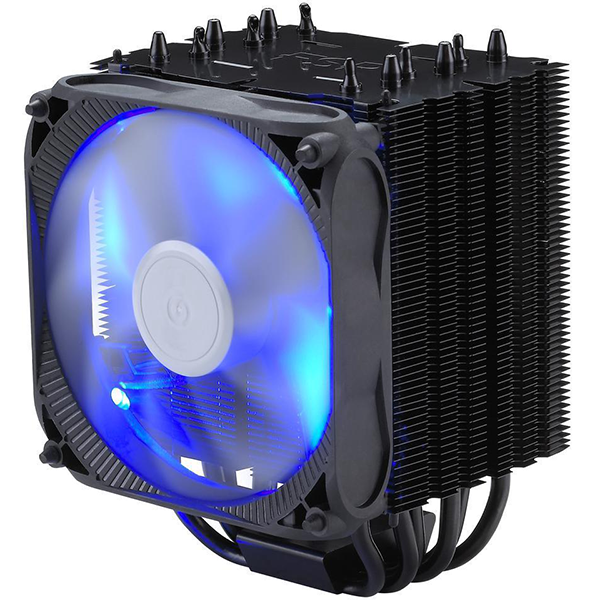Enermax ETS-T50 Axe Cooler Review: Solid-Value Air Cooling
Why you can trust Tom's Hardware
Comparison Coolers, Testing Results & Conclusion
Standardized data collected from our Intel Core i7-5930K test system from previous CPU cooling reviews allows us to graph and evaluate various air and liquid coolers. We will look at the Enermax ETS-T50 Axe alongside the Scythe Grand Kama Cross 3, the FSP Windale 6, and the Cooler Master MasterAir MA610P. All of these are moderately large, heatpipe-equipped CPU aircoolers.
The ETS-T50 Axe turned out almost exactly group-average temperatures in our Prime95 load periods at both full and half fan speeds. It also pleasantly surprised us by turning in the coolest reported values from our motherboard voltage-regulator thermal probe, proving it is able to cool not only our processor, but also the surrounding hardware.
The Enermax 1800 RPM fan clocked in just a bit over its rated speeds, which does give it the fastest rotational speed of our testing group at both full and half speed. However, we see that higher fan speeds also result in higher noise output.
In a rather surprising turn, the ETS-T50 Axe, with its group-fastest fan speeds, had the second lowest decibel readings, if only by the smallest of margins, with the FSP Windale 6 sneaking in with the lowest 100% reading and the Cooler Master MasterAir MA610P with the lowest 50% reading. Enermax did, however, walk away with the lowest average decibel reading.
Considering how well the Enermax ETS-T50 Axe performed against its peers in the group, it is no surprise that we see a strong showing in our acoustic efficiency chart when we evaluate relative thermal performance against sound-level performance.
Our overall Performance Value results showed the ETS-T50 Axe finishing second behind the FSP Windale 6, due to the latter's slight acoustics edge and small edge in unit retail cost. The Enermax ETS-T50 Axe wiggled just under our average unit cost with a current price of $52; however, the FSP Windale 6 stretched out a bit in our final evaluation due to a slightly lower retail price.
With straightforward good looks and no-frills lighting, the Enermax ETS-T50 Axe provides solid cooling performance for most modern processor platforms at a reasonable price. By integrating the mounting screws into the cooler base, it is literally a snap to complete cooler installation by attaching the fan and directional shroud mounts onto the cooler. We enjoy simple cooler installations, especially since they allow us to dive into our testing that much more quickly.
Get Tom's Hardware's best news and in-depth reviews, straight to your inbox.
MORE: Best CPU Cooling
MORE: How To Choose A CPU Cooler
MORE: All Cooling Content
- 1
- 2
Current page: Comparison Coolers, Testing Results & Conclusion
Prev Page Features & Specifications
Garrett Carver is a contributor for Tom’s Hardware, primarily covering thermal compound comparisons and CPU cooling reviews; both air and liquid, including multiple variations of each.
-
HEXiT i like what they have done with the fan shroud as the blades of the fans dont exceed the hight of the cooling fin stack which means in theory the fan is more efficient... but they have lopped out chunks of the cooling surface which means the air will try and flow out of them reducing the effective cooling and air flow over the rest of the cooling stack.Reply
the whole thing could be a great cooler if they just go with straight edges on the fins that butt up directly to the back of the fan. but as it is i would have reservations. -
dish_moose If I recall black body radiators are the best at transferring heat - white may look pretty but ugly is as ugly does - meaning black would have been a more efficient choice.Reply -
rubix_1011 Enermax sent us the product SKU they wanted tested and reviewed, so it was a choice by the manufacturer in this instance.Reply -
Krazie_Ivan "When the PC boots up, the cooling fan runs a 10-second phase of reverse cycling to help rid the blade surfaces of dust accumulation."Reply
...how much does this actually help? seems like it would, but i've never read any testing. would be great on mobo's especially, & only require a simple bios update to add the option & maybe give it some adjustability. -
rubix_1011 According to their website, it must work in their opinion; http://www.enermax.com/home.php?fn=eng/product_a1_1_1&lv0=49&lv1=50&no=322Reply
The cooler was only installed in our lab test system for a couple days at most, so we don't see the long-term effects for a feature like this. However, if anyone does have the cooler and has some personal insight, I would be willing to hear what it is. -
photonboy Hexit,Reply
I don't understand your logic about the cut-outs affecting air flow. The holes next to the heat pipes? That's intentional, I assume for turbulence in the way that pits on golf balls make it go further than a flat ball.
Ignoring that for a second, even if the air was diverted to the layer above or below then so what? The air is still passing by a flat heatsink surface and thus pulling away heat.
Besides, what really matters are the TESTS for noise vs cooling and that you have. No need to SPECULATE about performance issues when there is actual data. -
HEXiT if you look at the front face of the cooler where you attach the fans. there are cut outsReply
which means theres a gap between the back face of the fan and the front face of the cooling fins. air like water will choose the path of least resistance so if theres a gap the air will try to flow out of that rather than pass through the fins.
if the fins butted directly up against the fan with no gap then the air would have no option but to pass through the fins. which would make the cooler more effective as it would increase the static pressure.
i do like the fact that they have blocked off the sides of the fin stack as this forces the air to flow thought the entire stack instead of it evacuating out the sides. but the gaps in the front face may negate any advantage to cooling that the blocking of the sides should bring. -
Olle P Reply
A distance is actually better since it helps the distribution of air between the fins.20782865 said:... the whole thing could be a great cooler if they just go with straight edges on the fins that butt up directly to the back of the fan.
A tiny amount of air will probably leave at the gap, but less than you think.
Mixing apples and pears...20785403 said:If I recall black body radiators are the best at transferring heat - white may look pretty but ugly is as ugly does - meaning black would have been a more efficient choice.
* Black body radiators are very efficient, provided they're hot enough. >1,000 degrees on the surface it's great for cooling in a vacuum environment. Our Sun is a prime example of a black body...
* For convectors, which this cooler is, it's best to have no paint at all, since the paint act as an insulator. Black paint is the worst, since it will absorb radiated energy from the surroundings.







